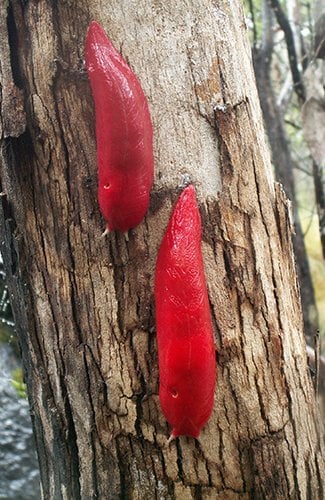The giant pink slugs of Mount Kaputar

A PARK RANGER at Mount Kaputar National Park in northern New South Wales has snapped incredible photos of hot pink slugs that grow to an enormous 20cm in length.
Ranger Michael Murphy says on mornings after rain you can sometimes see hundreds making their way back down the trees after a night foraging for lichen and moss.
These festively coloured slugs (Triboniophorus aff. graeffei) are relations of the equally quirky red triangle slug, which is also found on Mount Kaputar. They are among a number of unique species marooned 1500m above sea level on an extinct volcano near the township of Narrabri.
The slug’s huge size is a family trait says Michael, but he also puts it down to the abundant food and lack of predation in their wet 10sq.km patch of habitat.

High altitude slugs
Only discovered a few years ago, the slugs have maintained a low profile due to their remote location Michael says.
At their largest they reach roughly the length of a paperback book and a width of 4–6cm. It’s hoped says Michael that with their charismatic colour and size, these slugs could be a bright new figurehead for the many more-dowdy threatened invertebrates.
“There are more land snails listed as threatened, endangered or extinct by the International Union for the Conservation of Nature (IUCN) than birds, mammals, reptiles, amphibians and fish put together,” says Michael, a trained biologist whose speciality is land snails.
Many days you might see nothing in the pink slugs habitat he says, but on others the forest will be alive with invertebrates.
Their damp, canopied patch, which is also home to the Kaputar hairy snail, the Kaputar cannibal snail and a dozen other important species, is on its way to becoming Australia’s first land-snail habitat to be declared an endangered ecological community. It’s something that should bring some attention to the impact of climate change on mountain invertebrates, says Michael.
And why pink you ask? “There’s one idea that the pink colour camouflages them against the colour of fallen snow gum leaves on the forest floor,” says Michael. “But then again they spend a lot of their time way up in the canopy nowhere near the floor… so it might just be that if you’re a giant slug way up on an isolated mountain top, you can be whatever colour you like.”
RELATED STORIES




